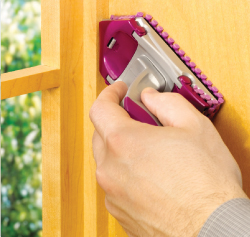
The ergonomically designed SandBlaster detail
tool can be used with either a sanding or
finishing pad
For many home projects, sandpaper is often needed to complete the preparation of a surface that will be painted, especially wood or glossy surfaces. The coarseness of sandpaper is graded on a scale from 12 (extra coarse) to 1,500 (ultra-fine). The smaller the number is, the coarser the grit.
Sandpaper comes in two styles: open coat and closed coat. Coat refers to how densely the grain is adhered to the surface. Open-coat sandpaper has greater spacing between the grains, which prevents it from clogging up as quickly with sanding residue. Closed coat means 100 percent of the surface is covered with grain, so it fills more rapidly with sanding residue and must be discarded sooner.
The back of each sandpaper sheet contains important labeling information including abrasive type, grit size, whether it is open or closed coat, and backing. The backing weight is rated by letter, with “A” being the thinnest weight. Backings with a “C” or “D” rating are the best options for heavy sanding of wood, while “X” is effective for heavy-duty sanding. Backing materials can vary from paper to cloth to fiber.
Here are the most common types of sandpaper:
Garnet
• A reddish-brown natural abrasive
• A special heat treatment produces
a tougher, sturdier grain
• Used exclusively for woodworking
• Not suitable for metal
Emery
• A black natural abrasive
• Used to polish metal surfaces
• Typically used with an oil
lubricant
Aluminum oxide
• A brown synthetic abrasive
• The most common general abrasive
• Hard and long-wearing
• Used on wood, metal or painted surfaces
• Well suited to finishing high-tensile materials such as steel, bronze and some hardwoods
Silicon carbide
• Hard and sharp
• Effective in sanding low-tensile materials such as cast iron, aluminum, copper, or plastic
• Useful between coats of finish
Alumina zirconia
• Harder than silicon carbide and tougher than aluminum oxide
• Used for grinding and shaping metal and wood
• Not used for polishing
3M SandBlaster flexible abrasives and accessories
The SandBlaster products from 3M are also great tools for sanding bigger projects. The abrasives sand faster and last longer than conventional abrasives of comparable grit and are available in flexible pads and sponges:
• Flexible sanding pads. Hardworking and efficient with the addition of the patented Cubitron mineral, the superior abrasive provides a smooth surface every time, yet is remarkably flexible to conform to easily to intricate surfaces. Washable and resistant to clogging, these sanding pads can be used over and over again. Available in two sizes and assorted grits. ($8–$10)
• Flexible finishing pads. The unique surface of this pad creates consistent tiny scuffs – micro cuts – that result in a smooth and polished finish with fewer sanding errors. The highly flexible pad reaches into the grooves, curves and corners of even the most detailed project. Assorted applications. ($8–$9)
• Sanding tools. These ergonomically designed tools feature soft-touch materials to offer the best in both comfort and performance. SandBlaster sanding tools help apply consistent, even pressure to create a smoother finish and can be used with either a sanding or finishing pad. Available in a detail-size tool or a larger tool. ($9-12)
• Wall sanding sponges. These sponges simplify prep work. The abrasive side is designed for spot sanding spackled wall repairs, paint drips or runs. The dense foam side allows sanding dust to be easily wiped away. Available in 100 or 150 grit. ($7)
Sanding-related products, such as rubber or wood sanding blocks, are also available and can produce more evenhanded sanding. Sanding sponges coated with or made of an abrasive agent are effective for some projects, as they can take the form of the item being sanded.
Tina Rotolo is the store manager and human resource director at Cole Hardware on Polk Street. She loves helping customers with do-it-yourself projects. Contact Tina or her staff at 415-674-8913 for any questions with your projects.